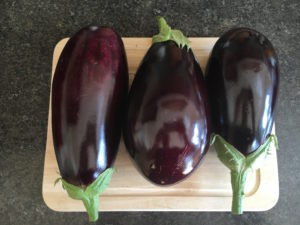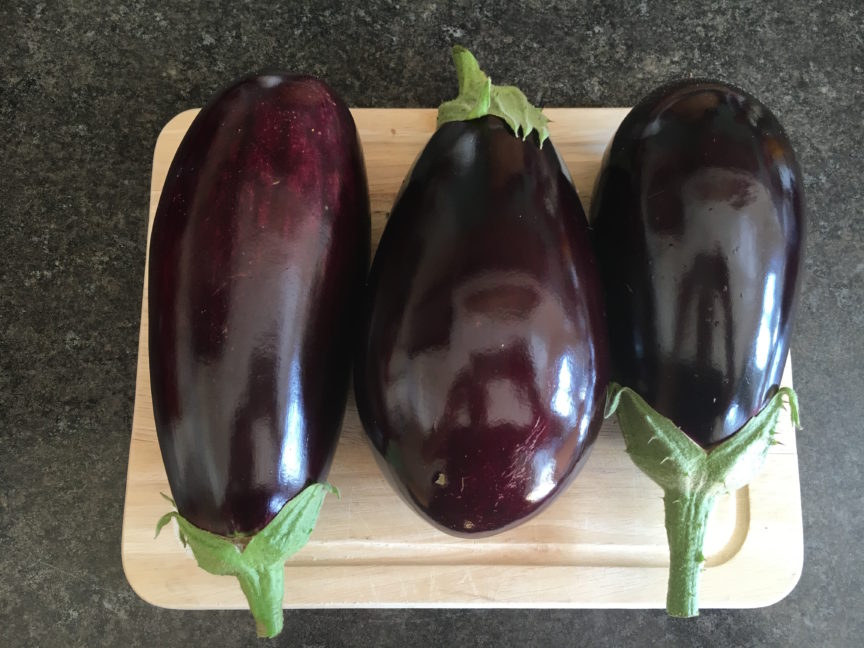 Aubergines are a bit ‘marmite’, in as much as they seem to divide opinion. There are those that revere them, and others that can’t stand them, or least can’t see the point of them.
Aubergines are a bit ‘marmite’, in as much as they seem to divide opinion. There are those that revere them, and others that can’t stand them, or least can’t see the point of them.
Cooked aubergine flesh is not really an acquired taste, because it’s not a strong one; there’s not a lot to overcome or get used to, though people might quibble about liking the texture of the cooked vegetable. Very soft once cooked, the gentle taste works well with many flavours, hence several cultures have a central dish using aubergines. Classic dishes are Italian parmigiana di melanzane, Greek moussakka and Persian dishes like baba ghanoush, or melitzanes papoutsakia (‘eggplant slippers’).
It may come as a surprise that along with tomatoes, potatoes and bell peppers, aubergines belong to the nightshade plant family. While most often associated with a lovely, shiny deep purple skin, it does come in other colours including a lighter shade (lavender) or shades of green, sometimes with strips, as well as orange and yellow varieties. And they come in various sizes too. The most popular variety of aubergine looks like a large, pear-shape something like an egg, hence the American name eggplant.
 Getting stuffed
Getting stuffed
The simplest dish can be eggplant hollowed out and stuffed with meat, rice, or other fillings, and then baked. Cooks might be put off by the time and effort needed to prepare the vegetable, as it is often recommended to tenderise aubergines by sprinkling cut slices with salt and allow to rest for about 30 minutes. This process draws out some of the plant’s water content along with some of the bitter components before washing the salt off.
When picking out an aubergine, its skin should be bright and shiny and when held it should feel firm and heavy for its size. Gently press the skin with the pad of your thumb. If it springs back, the aubergine is ripe; if an indentation remains, it is not. Aubergines are sensitive to both heat and cold. Store them in the fridge, where they will keep for a few days. Once cut, aubergine decays quickly. If you’re cutting up a lot, you can keep slices (or cubes) in water with a squirt of lemon juice in it.
 Aubergines are a good source of dietary fibre and vitamins B1, B6 as well as potassium, copper, magnesium and manganese. According to the BBC’s Good Food website, “Aubergines are high in fibre and low in fat and therefore recommended for those managing type 2 diabetes or managing weight concerns. Initial studies indicate that phenolic-enriched extracts of eggplant may help in controlling glucose absorption, beneficial for managing type 2 diabetes and reducing associated high blood pressure (hypertension). Aubergines may also help to lower LDL (bad) cholesterol levels. These positive effects are likely to be down to nasunin, and other phytochemicals in aubergines.”
Aubergines are a good source of dietary fibre and vitamins B1, B6 as well as potassium, copper, magnesium and manganese. According to the BBC’s Good Food website, “Aubergines are high in fibre and low in fat and therefore recommended for those managing type 2 diabetes or managing weight concerns. Initial studies indicate that phenolic-enriched extracts of eggplant may help in controlling glucose absorption, beneficial for managing type 2 diabetes and reducing associated high blood pressure (hypertension). Aubergines may also help to lower LDL (bad) cholesterol levels. These positive effects are likely to be down to nasunin, and other phytochemicals in aubergines.”
Read more at:
Foodnetwork/aubergine/eggplant slippers
Whfoods/aubergine
http://www.whfoods.com/genpage.php?dbid=22&tname=foodspice
Wikipedia.org/eggplant
https://en.wikipedia.org/wiki/Eggplant
The nutritional content of Aubergine
Aubergine cooked 100g. Low GI, 10g of carbohydrate, 35 calories, 10% fibre, 7% copper, Vitamin B1 7%, vitamin B6 5%, Vitamin B3 4%, Vitamin K 3% manganeses 6%, potassium 3% and folate 3%. Percentages are of your daily recommended intake.
Food features and recipes like this appear in the Desang Diabetes Magazine, our free-to-receive digital journal. We cover diabetes news, diabetes ‘kit’ and information on food suitable for maintaining good blood glucose control or a diabetic diet, including a regular Making Carbs Count column. It’s free! Go to the top of this page to sign up – we just need your email address. See current and past issues at
www.desang-magazine.co.uk
Open publication

